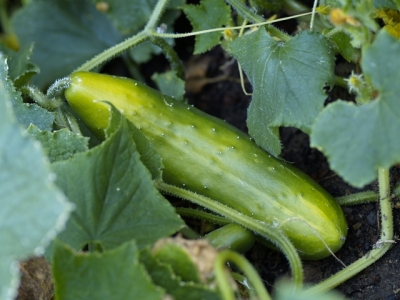Growing Cucumbers and Gherkins in the Vegetable Garden

Many of the modern outdoor, or ridge, cucumbers grow almost as easily as marrows and so are a welcome addition to a small kitchen garden. They are also longer and less prickly than the older types. They may be grown on the flat (although this takes up a lot of room) or they may be trained up a trellis or (like tomatoes) up a bamboo, or up a wigwam of bamboo sticks.
Gherkins are simply smaller-growing varieties of cucumbers. If lack of space is a serious problem and no greenhouse is available, you may grow the green house variety ‘Fembaby’ indoors in 300 mm (12 in) pots placed by a French window or in some other large, light area.
When growing cucumbers, sow seeds singly, at a depth of 20–25 mm (¾–1 in), in 75 mm (3 in) pots of proprietary potting compost, in late April to early May in a warm position indoors. Keep the seedlings moist and make sure they do not get scorched in strong sunlight. Harden them off under cloches or in a frame, then plant them out in late May or early June. Seed may alternatively be sown directly in the main plot from mid-May; sow two or three seeds at each point and thin to the strongest when the seedlings are established.

When growing cucumbers, the soil must be fairly light and well prepared, with as much compost as you can spare. For each plant dig a hole 300–400 mm (12 – 15-1/2 in) square and later capped with a 40–50 mm (1-½ – 2 in) mound of soil. The site should be warm and sunny. Young plants will be given a stronger start if protected for a week or two under cloches. In colder areas it may be advisable to grow the cucumbers in frames. Most cucumber plants must be spaced 750–900 mm (30–36 in) apart, but the ‘Patio-Pik’ variety and gherkins need a space of only about 600 mm (24 in). When about six leaves have grown on each plant, pinch out the growing tip to encourage the development of side shoots; these must then be trained against your supports.
Keep the soil well watered and weed-free at all times. Protect plants against slugs and snails with Draza pellets. Any moulds and mildews should be treated with a fungicide such as benomyl or one of the systemics.
Harvest the fruits when young; allowing them to mature fully will spoil their flavour and discourage the plant from producing more fruits. The ridge cucumbers should be 150–200 mm (6–8 in) long and the gherkins should be not more than about 75 mm (3 in).
Planting cucumbers:
1. The site should be warm and sheltered, with direct sunlight. Dig a hole at least 300mm (12 in) square and deep.
2. Thoroughly mix the dug soil with about the same amount of compost. Make sure that the mixture is not lumpy, then fill the hole with it.
3. Holding the plant by the root ball, lower it into a hole made in the mixture of soil and compost. Firm it in gently, then water it.
4. If you train the cucumber plant up a support, tie the stem securely at several points – it will later have to bear a considerable weight of fruit.
Recommended varieties: ‘Burpless Tasty Green’, F1, good under protection; ‘Conda’, F1, good-cropping gherkin; ‘Crystal Apple’, unusual pale-coloured, round cucumber; ‘Fembaby’, F1, for pot-growing indoors, short fruit; ‘Kyoto’, good for training up poles; ‘Patio-Pik’, may be grown closer, saving space; ‘Perfection’ (‘King of the Ridge’), a popular late-cropper; ‘Venlo’ (‘Venlo Pickling’), a favourite gherkin.
Site: Sunny, sheltered
Soil: Rich and moist, with compost well dug in
Sow: Late April—May indoors; late May—June outdoors
Harvest: Regularly, before fruits have matured fully
Related news
 Vitamin E discovery in maize could lead to more nutritious crop
Vitamin E discovery in maize could lead to more nutritious crop New research has identified genes that control vitamin E content in maize grain - a finding that could lead to improving the nutritional profile of this staple
 Aquaponics Farmers Band Together to Set Their Industry Apart
Aquaponics Farmers Band Together to Set Their Industry Apart Growers that add fish to their vegetable mix say they're combining the benefits of an ecosystem with the resource-efficiency of an water-based operation
 15 Impressive Spinach Benefits
15 Impressive Spinach Benefits The health benefits of spinach include skin care, improved eyesight, healthy blood pressure, stronger muscles, prevention of age-related macular degeneration